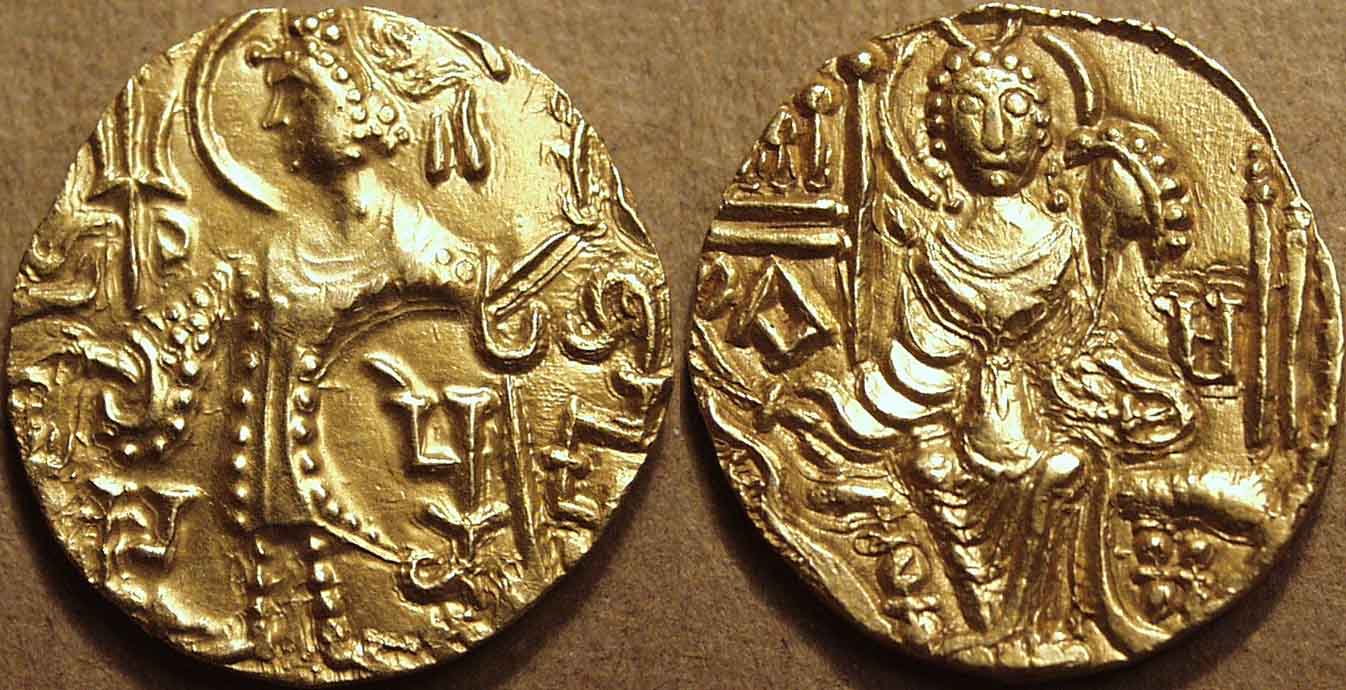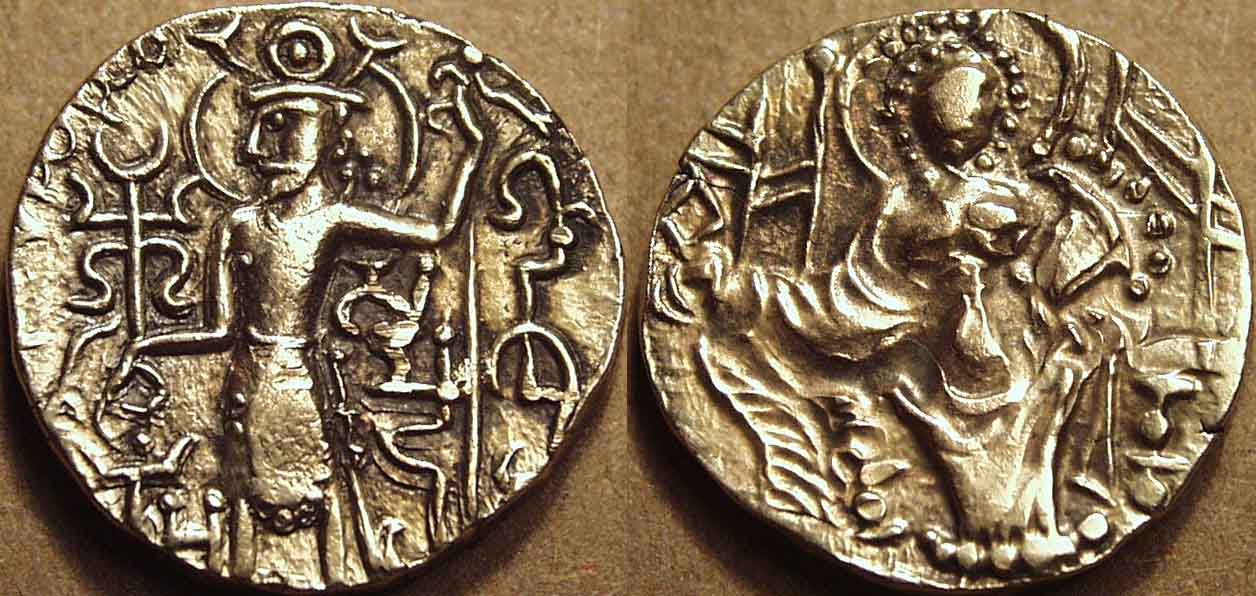
|
|
Presentations of Kushan coins normally end with the coins, shown here, that go under the name Gadahara, although it is not clear these are Kushan coins at all.
Certainly the Kushan "empire" was in its waning days and the Gadahara coins mark a period of transition to Hunnic rule in northern India. A Hun tribe that now go by the name
"Kidarites" were taking control. Whether the Gadahara coins were all issued by these Kidarites, or whether the transition took place mid-way or even after the end of this series
is not entirely clear. It is not even clear what the significance of the name "Gadahara" is. Some have thought it simply refers to the Gandhara region, others that it was a title or
the name of a king. Complicating matters is that the Gadahara coins all have another name under the king's arm, names that include Yasada, Piroz, Kirada and Samudragupta.
Two of these names - Piroz and Samudragupta - are the names of known kings of other dynasties. So the question is, what are there names doing on Gadahara coins? One
possible explanation for this is that the king named Gadahara was being pressed from all sides and so had to pay tribute, or attempted to pay homage, to various powerful
neighbors.
|
 |
Gadahara-Yasada |

|
Gold dinar, c. late-4th century CE
Weight: 7.80 gm., Diam: 18-19 mm., Die axis: 12 o'clock
Crowned, diademed King standing facing, nimbate, holding standard and sacrificing at altar at left,
Brahmi legend: Gadahara at right, yasada or zada under arm, kushana at left /
Goddess of plenty Ardochsho enthroned facing, holding diadem and cornucopia,
Brahmi letter ta at right, tamgha at left
Göbl 600 |
 |
The letters under the king's arm are ya sa da. It is not clear if they are meant to be read as three separate letters
or if the ya sa are meant as a compound ysa, which I have shown in a recent paper would
represent the sound za, making the word zada = "son of." The coin would then perhaps represent an issue of Gadahara-zada, the son of Gadahara. Since we
do not have any coins of Gadahara alone, it's not clear how attractive an idea this is, but we then have no idea what Yasada might mean. |
 |
 |
 |
Gadahara-Piroz |

|
Gold dinar, c. late-4th century CE
Weight: 7.80 gm., Diam: 21-22 mm., Die axis: 12 o'clock
Crowned, diademed King standing facing, nimbate, holding standard and sacrificing at altar at left,
Brahmi legend: Gadahara at right, piroz under arm, kushana at left /
Goddess of plenty Ardochsho enthroned facing, holding diadem and cornucopia,
Brahmi letter sha at right, tamgha at left
Göbl 608 |
 |
The letters under the king's arm are normally read as Piroyasa. But I have shown in a recent
paper that the correct reading is Piroz. It is most likely this refers to the Kidarite king by that name who is
also called Peroz III in lists of Kushano-Sasanian kings. |
 |
 |
 |
Gadahara-Kirada |

|
Gold dinar, c. late-4th century CE
Weight: 7.80 gm., Diam: 20-21 mm., Die axis: 1 o'clock
Crowned, diademed King standing facing, nimbate, holding standard and sacrificing at altar at left,
Brahmi legend: Gadahara at right, kirada under arm, kushana and ru at left /
Goddess of plenty Ardochsho enthroned facing, holding diadem and cornucopia,
Brahmi letter yasha at right (off flan), tamgha at left
Göbl 607 |
 |
Whether Kirada is the same as Kidara is not entirely clear, although it is probably a different name. |
 |
 |
 |
Gadakhara-Samudra |

|
Gold dinar, c. late-4th century CE
Weight: 7.57 gm., Diam: 19-20 mm., Die axis: 12 o'clock
Crowned, diademed King standing facing, nimbate, holding standard and sacrificing at altar at left,
Brahmi legend: Gadakhara at right, Samudra under arm, pu at left /
Goddess of plenty Ardochsho enthroned facing, holding diadem and cornucopia, tamgha at left
Göbl 611 |
 |
A remarkable coin still holding on to its many secrets! Clearly the name under the arm here refers to Samudragupta,
whose power was growing in north India throughout the 4th century. The name in the right field, Gadakhara, is in all probability a simple variant of Gadahara. So
the coin seems to belong to this series. But note the highly different crown, with solar and lunar motifs, and the crescent-topped trident over the altar. So the coin is quite
different from its predecessors as well. Whether it was issued by Gadahara in tribute to Samudragupta, or, more likely, was issued by Samudragupta (or his governor) in imitation
of the previous Gadahara coinage, is not definitely known. |
 |
 |
 |
Copper Coins |

|
Copper unit, c. late-4th century CE
Weight: 2.27 gm., Diam: 15-18 mm., Die axis: 8 o'clock
Bust of King right, wearing crown with turret, "artichoke" and ram's horn /
Goddess of plenty Ardochsho seated facing on couchant lion, holding diadem and cornucopia,
Brahmi legend: Gada at right, hara at left, ta at top left
Tandon, JONS 200, coin 1 |
 |
A remarkable coin that I have published and discussed in JONS 200 (link above). It does not resemble any other Kushan
coin ... rather, it is a close cousin to a Sasanian style silver drachm issued by the Kidarite king Peroz III. The question is whether it proves that all the Gadahara coins were
issued by the Kidarites, or whether the Gadahara name still commanded enough respect and authority for other rulers to want it on their coins. The following coin shows the
hara and the ta monogram better than this coin. |

|
Copper unit, c. late-4th century CE
Weight: 2.02 gm., Diam: 17-20 mm., Die axis: 7 o'clock
Bust of King right, wearing crown with turret, "artichoke" and ram's horn /
Goddess of plenty Ardochsho seated facing on couchant lion, holding diadem and cornucopia,
Brahmi legend: Gada at right, hara at left, ta at top left
Tandon, JONS 200, coin 2 |
|
|